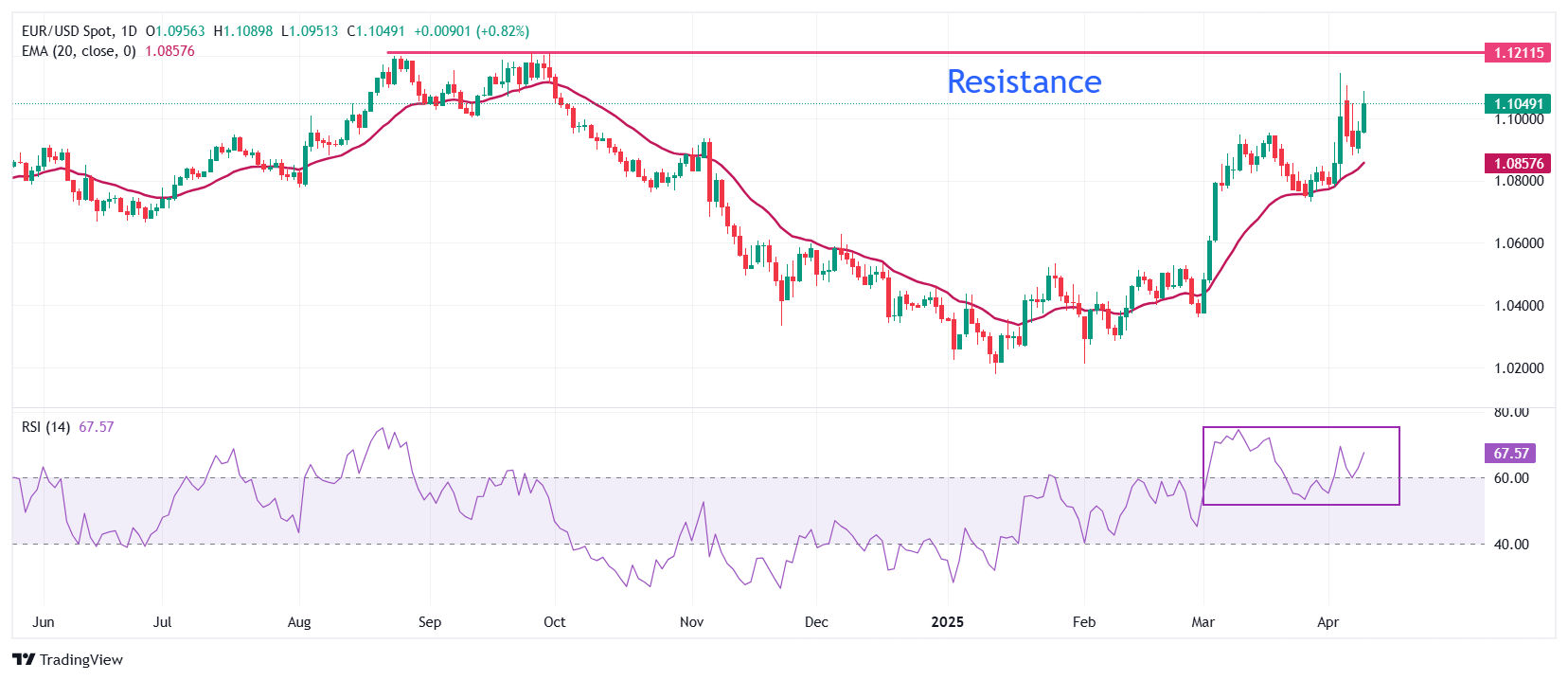-
EUR/USD surges toward 1.1100 as the US Dollar weakens amid escalating US-China trade tensions.
-
China vows retaliatory action in response to President Trump’s steep reciprocal tariffs.
-
ECB’s Šimkus signals support for an interest rate cut at the April meeting.
EUR/USD rallied near the 1.1100 level in Wednesday’s North American session, driven by renewed weakness in the US Dollar amid escalating US-China trade tensions. The pair gained strength as traders reacted to a fresh wave of counter-tariffs from China and growing expectations of a Federal Reserve rate cut.
During European trading hours, China announced that it would raise tariffs on US goods to 84%, effective April 10, in response to President Trump’s recent move to hike reciprocal tariffs on Chinese imports to 104%. In a sharply worded White Paper, Beijing pledged to take “resolute countermeasures” to protect its economic interests and rejected what it described as “unilateral and bullying” actions.
The rapid escalation in the trade conflict has heightened fears of a global economic slowdown, with analysts warning of potential recession risks. JPMorgan noted that China’s role as the world’s manufacturing hub could complicate global supply chains and weaken demand, with ripple effects across major economies, including the Eurozone.
The growing uncertainty has led investors to bet on renewed monetary easing from the Federal Reserve. The CME FedWatch Tool shows the probability of a rate cut in May has surged to 52.5%, up sharply from just 10.6% a week ago. Expectations for a June cut are even stronger.
Minneapolis Fed President Neel Kashkari added to the dovish tone, warning that Trump's tariff policy could trigger near-term inflation, reduce consumer purchasing power, and hamper GDP growth.
Traders are now eyeing the FOMC minutes from the March meeting for insights into the Fed’s next steps. The minutes, due later Wednesday, are expected to reflect the Fed’s cautious stance amid policy uncertainty.
Euro Gains Support from German Political Deal, But Risks Loom
- The Euro also gained traction following a political breakthrough in Germany. The center-right CDU and center-left SPD reached a coalition agreement, which could facilitate fiscal initiatives like debt restructuring and infrastructure investments. However, optimism is tempered by Trump’s threat of imposing 20% tariffs on Eurozone imports, with investors fearing significant headwinds for German exports.
- In response, EU member states agreed to coordinate countermeasures, while also leaving room for negotiations with the US. A spokesperson from the European Commission said these measures could be paused if the US agrees to a “fair and balanced” outcome.
- Poland’s Finance Minister warned that tariffs could disrupt supply chains and strain Eurozone growth, placing additional pressure on the Euro and prompting further discussion among Euro-area finance ministers at a meeting in Warsaw on Friday.
- Meanwhile, dovish comments from ECB policymakers suggest that monetary easing may be on the table. ECB Governing Council member Gediminas Šimkus said the recent US tariff move may warrant a 25 bps rate cut in April to support the Eurozone economy, calling for a “less restrictive” stance.
EUR/USD Technical Outlook: Bullish Bias Intact

Technically, EUR/USD continues its bullish run, trading above the 20-day Exponential Moving Average (EMA) at 1.0856. The 14-day Relative Strength Index (RSI) has bounced from near 60.00, indicating renewed bullish momentum.
Key support lies around the March 31 swing high of 1.0850, while resistance looms at the September 25 high of 1.1214. A clear break above the six-month high of 1.1147 could open the door to further upside in the short term.





